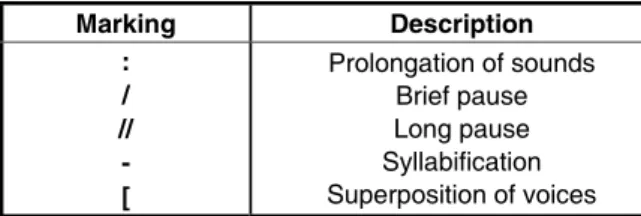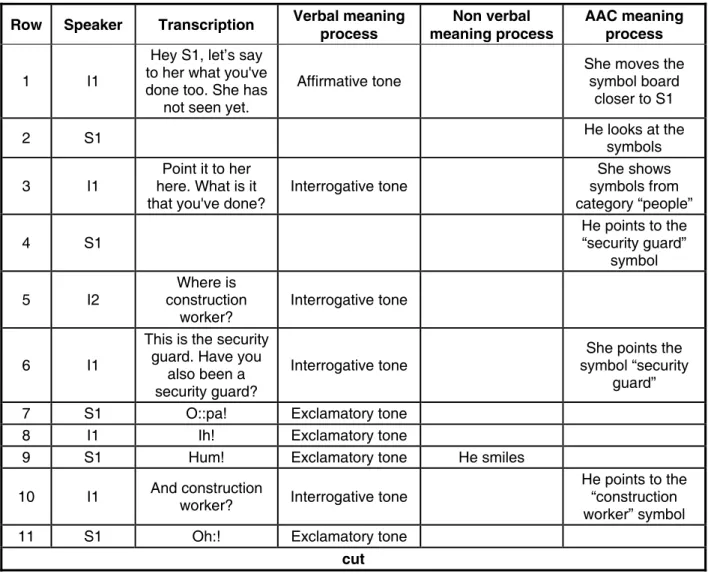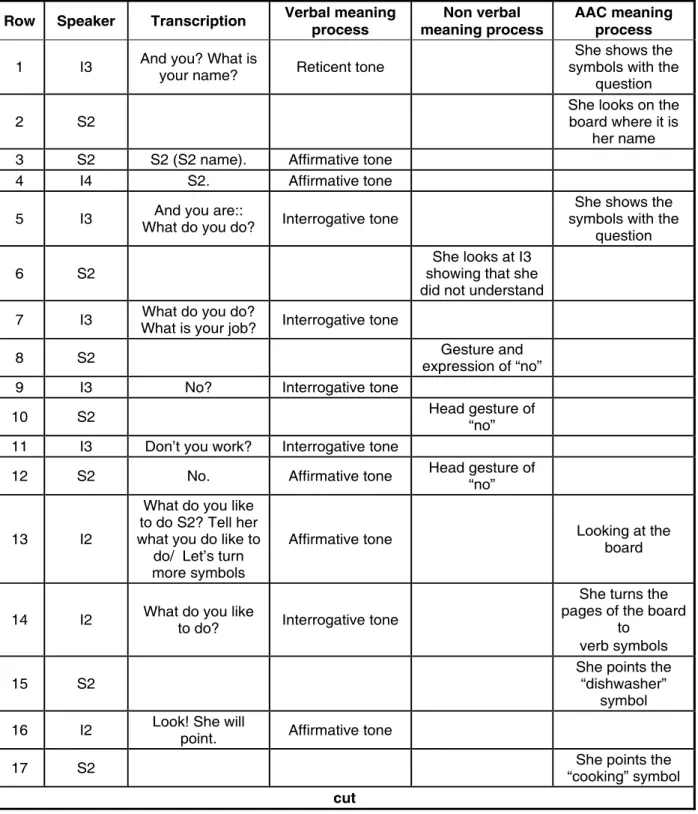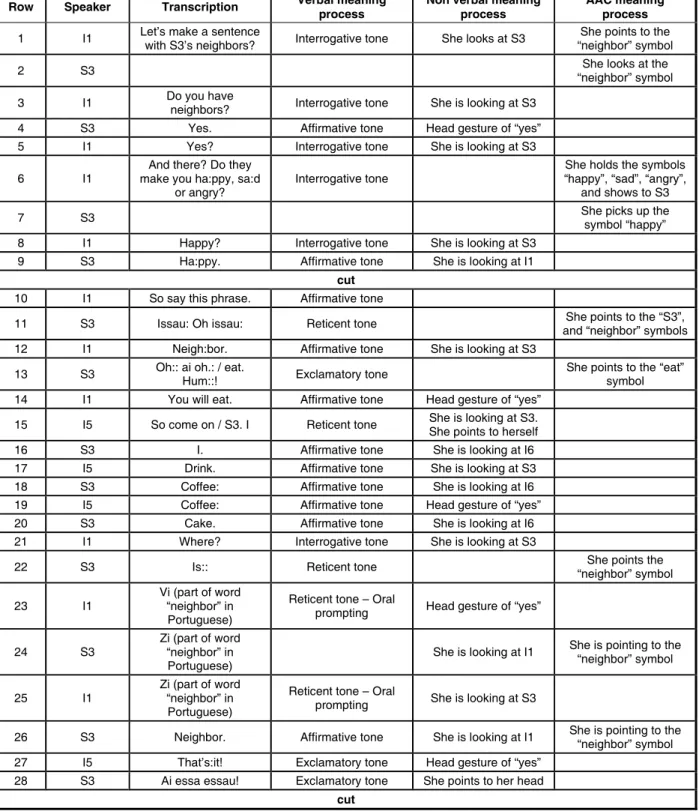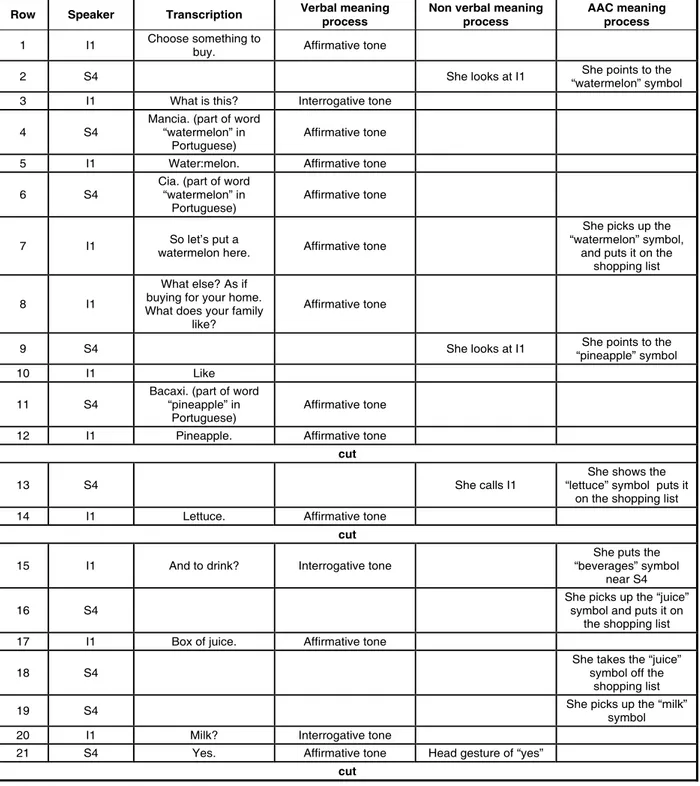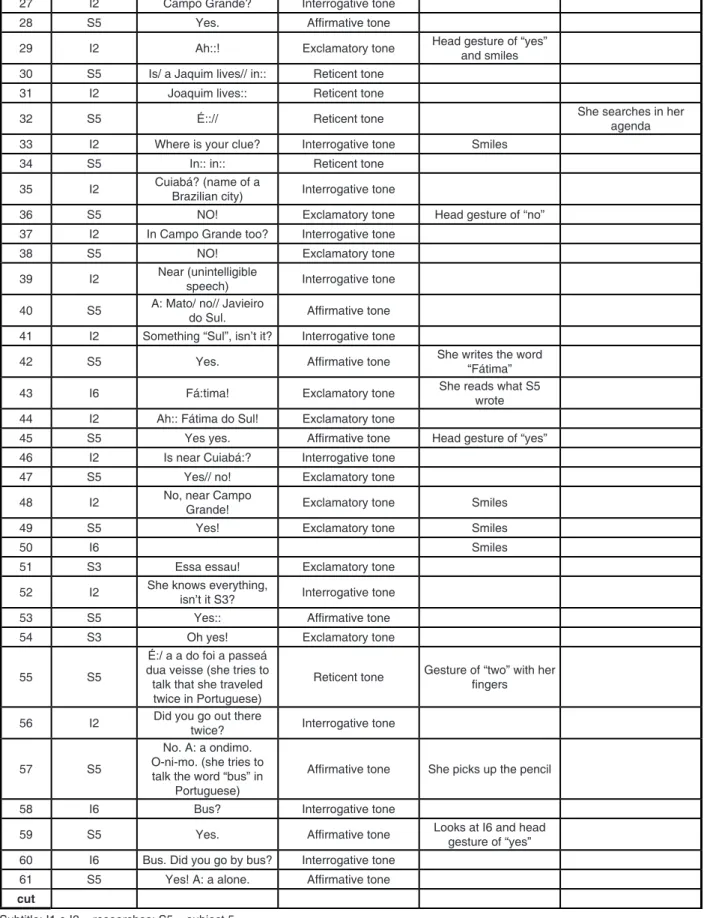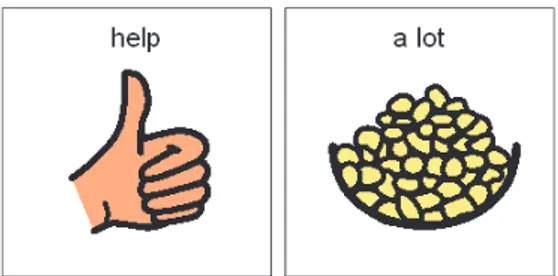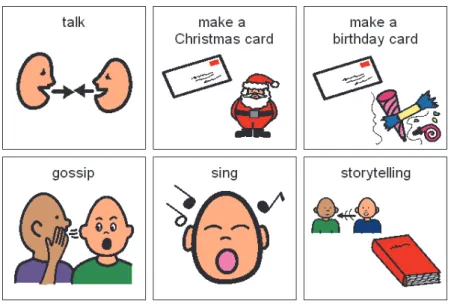AUGMENTATIVE AND ALTERNATIVE COMMUNICATION
REPERCUSSION ON NON-FLUENT APHASIA
Repercussão da comunicação suplementar
e/ou alternativa na afasia não luente
Mariana Mendes Bahia (1), Regina Yu Shon Chun (2)
(1) Universidade Estadual de Campinas – UNICAMP, Campi-nas, São Paulo, Brasil.
(2) Curso de Graduação em Fonoaudiologia e do Mestrado Proissional Saúde, Interdisciplinaridade e Reabilitação da Universidade Estadual de Campinas – UNICAMP, Campi-nas, São Paulo, Brasil.
(12%)1. Furthermore, over 9 million of those deaths are related to individuals under 60 years and could have been prevented1.
Over the last few decades, the NCDs have also become the leading cause of death in Brazil2. They are responsible for 74% of deaths, having cardio
-vascular diseases alone accounting for 33% of this
total1. Among the cardiovascular diseases, stroke is currently the second leading cause of death worldwide and the irst in Brazil3-5, representing, thus, a serious public health issue6. It is also considered the leading cause of physical disability in adulthood7. Dependence and inability to perform daily tasks occur due to several sequelae resulting from stroke, which could be physical, functional, emotional and/
INTRODUCTION
The Chronic Noncommunicable Diseases (NCDs) are the worldwide leading cause of death, accounting for 63% of the 57 million deaths in 2008, according to the World Health Organization – WHO1. Regarding the deaths caused by NCDs, cardiovascular diseases account for 48%, followed by cancer (21%) and chronic respiratory diseases
ABSTRACT
Purpose: verify the communication forms and linguistic-cognitive performance of aphasics from an Augmentative and Alternative Communication (AAC) perspective and to evaluate their perception. Methods: this is a longitudinal research with qualitative approach, approved by the Ethic and Research Committee. The sample includes 5 non-luent subjects with aphasia. Data was collected analyzing the subjects’ iles, video records of speech and language therapy focused on AAC, and the subjects opinions about it. Results: subjects used several ways of communication to express themselves as well as increased their use of AAC. In doing so, they demanded less gestures support during the study, which facilitated their communication and diminished guessing and frustrated conversation attempts. The use of AAC resulted in the increase of oral production. Subjects referred that they enjoyed using AAC and that it contributed to their communication in some way. Conclusion: results showed that AAC support contributed to subjects so they could assume their position as speakers, overcoming their language dificulties. Therefore it has facilitated them to assume themselves as linguistic and social subjects. Dialogic and contextualized activities, as well as the interlocutor mediation, facilitated the process of (re)signiication of their enunciations. Therefore, regarding this context, AAC is an important support that mediates and facilitates the linguistic process on non-luent aphasias with repercussions on oral production.
Given the above, it is interesting to investigate the impact of the use of AAC in assisting the language processes of non-luent aphasic subjects. The overall objectives are to verify the communication forms and the linguistic-cognitive performance of the subjects in a speech and language therapy implementing AAC, and to evaluate their perception regarding the resources of AAC. The speciic objec
-tives are: a) to acknowledge the communication forms used before and after implementation of AAC; to analyze the linguistic and cognitive performance on the aspects of oral and written production, use of gestures, understanding and use of AAC resources, and need for help and mediation after the imple
-mentation of AAC; and c) evaluate the subjects’ perception of communication and AAC use.
METHODS
This is a qualitative, longitudinal research. Its corpus is composed of 5 non-luent aphasics from the Group II of the Aphasia Center (CCA – IEL / UNICAMP), who participated in the AAC speech and language therapy. The subjects (or their legal guardian) agreed to participate by signing a Free and Clariied Consent Term. This study was approved by the UNICAMP Ethics in Research Committee.
The subjects were selected based on their oral
language impairment and their interest in using AAC.
Data were gathered from three sources:
a) institutional records, to characterize the subjects based on their aphasia history, cognitive-linguistic conditions, and use of AAC resources;
b) video recordings of the AAC speech and language therapy, to analyze language aspects of the subject after using AAC, taking into account the use of communication forms – oral and written language, own gestures, facial expressions, AAC resources, and need for assistance and mediation. The videos were recorded during a period of 27 month (03/2007 to 06/2009), accounting for 50 meetings. Of these meeting, we selected 19 for transcription, according to the research objectives;
c) subjects’ reports about communication and AAC use. For this purpose, we used a communi
-cation board with Pictographic Communi-cation System (PCS) symbols.
The speech and language therapy occurred in 60-minute weekly meetings, conducted by the researchers and volunteers (undergraduate students from the Speech and Language Graduation Course at UNICAMP). We elaborated communication boards for each subject, including PCS symbols. The PCS was used because its symbols are easily recognizable and have a Portuguese version, and Language disorders account for the greatest
functional impairment among all the possible sequelae following a stroke8. Moreover, stroke is responsible for 58% of language disorders, and patients who have had stroke may develop serious linguistic and cognitive disorders8. It is estimated that 40% of patients with acute stroke have aphasia. Half of those patients still present language disorders during the chronic phase11, which requires intervention and rehabilitation.
This study focus on aphasia, a language disorder related to comprehension and/or expression and similar language processes. Speciically, we address the aphasia impacts on various aspects of subjects’ life. Aphasia not only affects language, but also interferes with its related processes, such as practical life and social and affective relationships9. Moreover, it can also impact interactive and inter -pretive relations9,10.
We focus on non-luent aphasia, one of the aphasia categories. Non-luent aphasia patients present fragmented phrases with paraphasias, prolongation of sounds, dificulties in deployment and coordination and execution of phono-articu -latory movements12. For this reason, it is important to acknowledge the linguistic constructions of the aphasics speech, as well as the social context, the interaction and how they use language10,12,13. Therefore, during the (speech and language) therapeutic follow-up of aphasia, it is important to examine the conditions of oral and non-oral discourse production, taking into account dialogues and narratives in a dialogical and contextual perspective beyond an understanding of the social individual participating in the (re) constitution of his
language.
According to some authors14, aphasics often do not improve their condition as a result of clinical follow-up and these efforts may be insuf
-icient for language evolution. In those cases, the Augmentative and Alternative Communication (AAC) is as a therapeutic possibility13,15 – 17.
AAC is a tool for language mediation, which favors language itself, the (re) constitution of subjects with language disorders, and quality of their interaction13. It can be understood as a clinical and educational approach that aims to support, complement, supplement/augment, or replace the production and verbal interpretation forms of non-speaking subjects or of subjects with extreme
Brief characterization of the subjects and the use of AAC
Subject 1 (S1)
59 years old, male, divorced, construction worker. He had four stroke episodes in a period of four years, presenting right hemiplegia and global aphasia. The subject has limited oral communication and verbal and gestural stereotypies during speech, such as “opa”, and a circle gesture with his hands. According to his sister and caregiver, S1 does not participate in family celebrations and other events requiring exposition. He joined the AAC speech and language therapy group in 05/2006, being active and showing interested in working with AAC, especially in activities related to recalling his life story.
Subject 2 (S2)
37 years old, female, single, maid. She had two stroke episodes in a period of two and a half years, presenting the following sequelae: afferent motor aphasia, right hemiparesis, oral apraxia, and emotional lability. The subject shows reduced verbal expression and comprehension problems. According to her brother, S2 does not like attending public places and has bouts of crying and laughter. Quickly adopted AAC as a communication form, not showing dificulties in understanding the activities presented to the group. She was the latest partic
-ipant to join the group, in 06/2007.
Subject 3 (S3)
50 years old, female, single, occupational therapist. She had a rupture of a cerebral aneurysm over 20 years ago, affecting the left middle cerebral artery. As sequelae, she presented efferent motor
aphasia, dysarthria, and right hemiparesis. She has
dificult speech sequencing and verbal stereotypies, such as “preciso falar” (I need to speak), “issau”, “ai senhor” (Oh, God) and “ótimo” (great). The subject beneits from oral and visual promptings in dialogical situations, has good comprehension and uses several means to be understood. Moreover, she likes to sing and has preserved the melodic struc
-tures of songs. She began working with the AAC in 05/2006, being very collaborative and participatory in the activities, and assisting the other participants on their dificulties.
Subject 4 (S4)
59 years old, female, married, housewife. She had a stroke in 2000, which caused efferent motor aphasia with traces of dynamic aphasia and predominantly brachial right hemiparesis. The also because this system is the most commonly
used in Brazil.
Additionally, we conducted contextualized activities from a discursive perspective, in order to attribute meaning to the production forms of the subjects. In these activities, we sought to value the facts and situations brought by the participants, such as their personal life story, news, songs, poems, recipes, games, and other activities of interest for
the group13. During these activities, we offered PCS symbols related to the themes of the meeting.
The transcription of the selected episodes follows the Neurolinguistic Database coding system20. Data are presented according to the row number, speaker’s identiication, orthographic transcription, observation on the verbal meaning processes, observation on the nonverbal meaning processes, and an additional column with observations on the AAC meaning processes. It is also relevant to mention that, since all therapy was conducted in Portuguese, in this paper we present a free trans
-lation adapted from the original transcriptions. In Figure 1 we show the transcription markings:
Figure 1 – Transcription markings
Marking Description :
/ // - [
Prolongation of sounds Brief pause Long pause Syllabification Superposition of voices
The subjects’ reports were guided by the following questions:
1) How do you talk to people about what you want?
2) Do you think the communication board and the symbols can help you to communicate with others?
3) What activities do you like to perform with help of the communication board and the symbols?
RESULTS
The results are presented in three parts: charac
-terization of subjects, impact of AAC on language, and reports about their use of AAC as a communi
increase in oral production. However, his few speeches were very important for him due to his physical and health condition after four lesional episodes. Moreover, we observed that S1 did not show the verbal and gestural stereotypies described in previous therapeutical reports. Regarding S2, we observed increased oral production for words, which demonstrates improvement. S3 was able to produce a few simple spoken sentences with the aid of pictures and words from the AAC symbols. There were fewer verbal stereotypies which, despite the intonation and the interlocutor’s comprehension of the speaker’s intention, most often undermine the speech. S4 produced more words over time, especially with the support of the visual and verbal AAC prompting and the verbal support from the interlocutor. For S5, the use of symbols combined with oral production increased over time, since the subject uses both resources at the concurrently. She also presented greater production of oral sentences. The subjects demonstrated to understand the proposals in therapeutic activities. S3 and S5 did not need help to perform the activities, whereas S1, S2 and S4 needed the help of others in their devel
-opment. In general, the subjects kept their attention on group activities, respected the discursive topics
and maintained them in dialogue. Additionally, the
subjects S3 and S5 also introduced new conversa
-tional topics. S3 and S5 also helped other members of the group in their activities and encouraged them. S3, especially, gave verbal prompting for the rest of the participants.
Furthermore, we observed a decrease in the mediations of the interlocutors. However, it is noteworthy that the mediation of meanings made by others is necessary and important for assigning meanings to the actions of individuals, maintaining the dialogical game and thus favoring the language of the subject. Regarding S1 and considering his large latency time for response, the decrease in
mediations provided and guaranteed him the time
required to complete his statements. For S5, the mediation of the interlocutor was hardly required because she presented great language potential and, consequently, operating language. The media
-tions were only necessary when she had dificulties in reproducing her own production due to the apraxia.
The impacts of the use of AAC in the language of the subjects are shown by some of the most relevant episodes drawn from video recordings.
subject shows lack of verbal initiative, requiring the other to start a dialogue and encourage interaction. She uses hand gestures and head to convey the desired message and asks her husband for help in order to make herself understood. She joined the AAC group in 05/2006 and demonstrated that she understood the proposed use for AAC, using it in her activities with no signiicant dificulties.
Subject 5 (S5)
67 years old, female, married, retired teacher. She had an episode of hemorrhagic stroke triggered by a hypertension crisis in 1996, causing afferent motor aphasia, oral apraxia, and dysarthria. The subject presents fragmented phrases with anomie, paraphasias and prolongation of sounds with facial, neck and body syncinesis. Furthermore, she shows great effort when speaking, accompanied by neck tension and pitched voice. The subject makes use of written communication. She started using AAC in 05/2006 and showed no dificulties in understanding and using the resources. With AAC, she built more elaborate statements, often not requiring the mediation of researchers.
Impact of AAC on language
The data extracted from the video recordings show that subjects make use of various communi
-cation forms to express the intended content, such as the use of PCS symbols, own gestures, facial expression, speech production, albeit restricted for S1 and S2, and writing, in the case of S5.
We found along the study, through the analysis of data, that the subjects made greater use of AAC and required less assistance from own gestures. Moreover, AAC facilitated communication and interaction with each other, and reduced guesswork and failed attempts to talk. Regarding the cases of S2, S3 and S5, the subjects were able to use easily the AAC resources, and, in several occasions, they could use those resources for achieving a more spontaneous communication.
S2, S3 and S4 took advantage of a visual and verbal prompting to access the desired word, since they had great dificulty in lexical access. S5 showed an adequate and more elaborate production, making use of pictures and writing to get to the spoken word.
Row Speaker Transcription Verbal meaning process
Non verbal meaning process
AAC meaning process
1 I1
Hey S1, let’s say to her what you've done too. She has
not seen yet.
Affirmative tone
She moves the symbol board
closer to S1
2 S1 He looks at the
symbols
3 I1
Point it to her here. What is it that you've done?
Interrogative tone
She shows symbols from category “people”
4 S1
He points to the “security guard”
symbol
5 I2
Where is construction
worker?
Interrogative tone
6 I1
This is the security guard. Have you
also been a security guard?
Interrogative tone
She points the symbol “security
guard”
7 S1 O::pa! Exclamatory tone
8 I1 Ih! Exclamatory tone
9 S1 Hum! Exclamatory tone He smiles
10 I1 And construction
worker? Interrogative tone
He points to the “construction worker” symbol
11 S1 Oh:! Exclamatory tone
cut Subtitle: I1 e I2 – researchers; S1 – subject 1
Figure 2 – S1: a new fact of subject’s life (13 months after AAC introduction)
In the episode transcribed in Figure 2, the use of the AAC favored the subject’s language. Although oral production was restricted (row 7, 9, and 11), his little production assumed large signiicance regarding his condition. At the time, the members were presenting themselves to S2, who was joining the group. Everyone knew that S1 had been a construction worker but were unaware that he had also worked as a security guard. By using AAC, S1 was able to talk about a new fact of his life (row 4).
Row Speaker Transcription Verbal meaning process
Non verbal meaning process
AAC meaning process
1 I3 And you? What is
your name? Reticent tone
She shows the symbols with the
question
2 S2
She looks on the board where it is
her name
3 S2 S2 (S2 name). Affirmative tone
4 I4 S2. Affirmative tone
5 I3 And you are::
What do you do? Interrogative tone
She shows the symbols with the
question
6 S2
She looks at I3 showing that she did not understand
7 I3 What do you do?
What is your job? Interrogative tone
8 S2 Gesture and
expression of “no”
9 I3 No? Interrogative tone
10 S2 Head gesture of
“no”
11 I3 Don’t you work? Interrogative tone
12 S2 No. Affirmative tone Head gesture of
“no”
13 I2
What do you like to do S2? Tell her what you do like to
do/ Let’s turn more symbols
Affirmative tone Looking at the
board
14 I2 What do you like
to do? Interrogative tone
She turns the pages of the board
to verb symbols
15 S2
She points the “dishwasher”
symbol
16 I2 Look! She will
point. Affirmative tone
17 S2 She points the
“cooking” symbol
cut Subtitle: I2, I3 e I4 – researchers; S2 – subject 2
Row Speaker Transcription Verbal meaning process
Non verbal meaning process
AAC meaning process
1 I1 Let’s make a sentence
with S3’s neighbors? Interrogative tone She looks at S3
She points to the “neighbor” symbol
2 S3 She looks at the
“neighbor” symbol
3 I1 Do you have
neighbors? Interrogative tone She is looking at S3
4 S3 Yes. Affirmative tone Head gesture of “yes”
5 I1 Yes? Interrogative tone She is looking at S3
6 I1
And there? Do they make you ha:ppy, sa:d
or angry?
Interrogative tone
She holds the symbols “happy”, “sad”, “angry”,
and shows to S3
7 S3 She picks up the
symbol “happy”
8 I1 Happy? Interrogative tone She is looking at S3
9 S3 Ha:ppy. Affirmative tone She is looking at I1
cut
10 I1 So say this phrase. Affirmative tone
11 S3 Issau: Oh issau: Reticent tone She points to the “S3”,
and “neighbor” symbols
12 I1 Neigh:bor. Affirmative tone She is looking at S3
13 S3 Oh:: ai oh.: / eat. Hum::! Exclamatory tone She points to the “eat” symbol
14 I1 You will eat. Affirmative tone Head gesture of “yes”
15 I5 So come on / S3. I Reticent tone She is looking at S3.
She points to herself
16 S3 I. Affirmative tone She is looking at I6
17 I5 Drink. Affirmative tone She is looking at S3
18 S3 Coffee: Affirmative tone She is looking at I6
19 I5 Coffee: Affirmative tone Head gesture of “yes”
20 S3 Cake. Affirmative tone She is looking at I6
21 I1 Where? Interrogative tone She is looking at S3
22 S3 Is:: Reticent tone She points the
“neighbor” symbol
23 I1
Vi (part of word “neighbor” in Portuguese)
Reticent tone – Oral
prompting Head gesture of “yes”
24 S3
Zi (part of word “neighbor” in Portuguese)
She is looking at I1 She is pointing to the
“neighbor” symbol
25 I1
Zi (part of word “neighbor” in Portuguese)
Reticent tone – Oral
prompting She is looking at S3
26 S3 Neighbor. Affirmative tone She is looking at I1 She is pointing to the
“neighbor” symbol
27 I5 That’s:it! Exclamatory tone Head gesture of “yes”
28 S3 Ai essa essau! Exclamatory tone She points to her head
cut Subtitle: I1 e I5 – researches; S3 – subject 3
to express by oral production (rows 13 and 22 to 26). In this episode, we also noticed the presence of oral stereotypies produced by S3 (rows 11 and 28). Such stereotypies sound to the interlocutor with diverse intonations and consistent with the speech, as if they were word substitutions for what S3 failed to produce due to her dificult lexical access.
In this episode (Figure 4), S3 uses multiple forms to communicate the desired content and thus keep the dialogue with her interlocutor, especially with the use of oral production (as observed in rows 4, 9, 13, 16, 18, 20, and 26), and with the use of AAC (rows 7, 11, 13, 22, and 24). Moreover, we observed that S3 relies on the interlocutor’s speech and on the symbols to access what she wants
Row Speaker Transcription Verbal meaning
process
Non verbal meaning process
AAC meaning process
1 I1 Choose something to buy. Affirmative tone
2 S4 She looks at I1 She points to the
“watermelon” symbol
3 I1 What is this? Interrogative tone
4 S4
Mancia. (part of word “watermelon” in
Portuguese)
Affirmative tone
5 I1 Water:melon. Affirmative tone
6 S4
Cia. (part of word “watermelon” in
Portuguese)
Affirmative tone
7 I1 So let’s put a
watermelon here. Affirmative tone
She picks up the “watermelon” symbol,
and puts it on the shopping list
8 I1
What else? As if buying for your home. What does your family
like?
Affirmative tone
9 S4 She looks at I1 She points to the
“pineapple” symbol
10 I1 Like
11 S4
Bacaxi. (part of word “pineapple” in
Portuguese)
Affirmative tone
12 I1 Pineapple. Affirmative tone
cut
13 S4 She calls I1
She shows the “lettuce” symbol puts it
on the shopping list
14 I1 Lettuce. Affirmative tone
cut
15 I1 And to drink? Interrogative tone
She puts the “beverages” symbol
near S4
16 S4
She picks up the “juice” symbol and puts it on
the shopping list
17 I1 Box of juice. Affirmative tone
18 S4
She takes the “juice” symbol off the
shopping list
19 S4 She picks up the “milk”
symbol
20 I1 Milk? Interrogative tone
21 S4 Yes. Affirmative tone Head gesture of “yes”
cut Subtitle: I1 – researcher; S4 – subject 4
subject’s language. The subject follows the topic of discourse in row 13 by doing her shopping list, even without the presence of the researcher, and signals such action by calling the interlocutor to show a new item on the list. Moreover, we observed that S4 is assisted by the picture in giving meaning to the symbol, as shown in rows 16 to 21.
The transcription above shows that S4 uses the AAC symbols several times (rows 2, 9, 13, 16, and 19), and these symbols work as a prompting for her to access the desired word and produce it orally, as occurred in rows 2 to 4 and 9 to 11. It is Important to consider the involvement of the researcher, who asks questions and assigns meanings to the actions of S4, building a dialogue and thus favoring the
Row Speaker Transcription Verbal meaning
process
Non verbal meaning
process AAC meaning process
1 I2
So come on. Mrs. S5/ Can we continue mrs. S5’s history? Can we?
Interrogative tone
2 S3 We can. Afirmative tone
3 I2 We can. So come on. Afirmative tone
4 S5
Cole (part of word in Portuguese), no, sister-in-law me mé is Amélia,
Lono:ra, a Ci:// Ci: Cirinija, a. a:: a::
Afirmative tone “sisters-in-law” symbolShe points to the
5 I6 She articulates the name that S5 is trying to speak
6 S5 A:: Afirmative tone
7 I6 Eu Afirmative tone – Oral
prompting
8 S5 Eunice, Aparecida. Afirmative tone (Eunice and Aparecida)“Sisters-in-low” symbol
9 I2 sisters-in-law?Are there four Interrogative tone
10 I6 Gesture of “ive” with her ingers
11 I2 Five sisters-in-law? Interrogative tone
12 S5 Yes yes. Afirmative tone
13 I2 What else? Interrogative tone
14 S5 É:// a my brother is two. Afirmative tone She points to the “two”
and “brother” symbols 15 I2 Two brothers. Afirmative tone
16 S5 A::/ a::/ a Jaquim:// no. Negative tone “brothers” symbolsShe points to the
17 I2
It is the opposite, isn’t it? What is written? What
name comes irst? Interrogative tone
18 S5 A/ a João and a Jaquim. (Brazilian names) Afirmative tone
She points to the “brothers” symbols (João and Joaquim)
18 I2 Joaquim. Afirmative tone
20 S5 He lives in Mato Gosso. (a state of Brazil) Afirmative tone
21 I2
Who lives in Mato Grosso? João or
Joaquim? Interrogative tone
22 S5 No. Is:: Afirmative tone Gesture of “two” with her ingers
23 I2 Both? Interrogative tone
Subtitle: I1 e I3 – researches; S5 – subject 5
Figure 6 – S5: talking about the family (34 months after AAC introduction) 27 I2 Campo Grande? Interrogative tone
28 S5 Yes. Afirmative tone
29 I2 Ah::! Exclamatory tone Head gesture of “yes” and smiles 30 S5 Is/ a Jaquim lives// in:: Reticent tone
31 I2 Joaquim lives:: Reticent tone
32 S5 É::// Reticent tone She searches in her
agenda 33 I2 Where is your clue? Interrogative tone Smiles
34 S5 In:: in:: Reticent tone
35 I2 Cuiabá? (name of a Brazilian city) Interrogative tone
36 S5 NO! Exclamatory tone Head gesture of “no”
37 I2 In Campo Grande too? Interrogative tone
38 S5 NO! Exclamatory tone
39 I2 Near (unintelligible speech) Interrogative tone
40 S5 A: Mato/ no// Javieiro
do Sul. Afirmative tone 41 I2 Something “Sul”, isn’t it? Interrogative tone
42 S5 Yes. Afirmative tone She writes the word “Fátima”
43 I6 Fá:tima! Exclamatory tone She reads what S5 wrote
44 I2 Ah:: Fátima do Sul! Exclamatory tone
45 S5 Yes yes. Afirmative tone Head gesture of “yes” 46 I2 Is near Cuiabá:? Interrogative tone
47 S5 Yes// no! Exclamatory tone
48 I2 No, near Campo
Grande! Exclamatory tone Smiles
49 S5 Yes! Exclamatory tone Smiles
50 I6 Smiles
51 S3 Essa essau! Exclamatory tone
52 I2 She knows everything, isn’t it S3? Interrogative tone
53 S5 Yes:: Afirmative tone
54 S3 Oh yes! Exclamatory tone
55 S5
É:/ a a do foi a passeá
dua veisse (she tries to talk that she traveled twice in Portuguese)
Reticent tone Gesture of “two” with her ingers
56 I2 Did you go out there twice? Interrogative tone
57 S5
No. A: a ondimo. O-ni-mo. (she tries to talk the word “bus” in
Portuguese)
Afirmative tone She picks up the pencil
58 I6 Bus? Interrogative tone
59 S5 Yes. Afirmative tone Looks at I6 and head gesture of “yes”
60 I6 Bus. Did you go by bus? Interrogative tone 61 S5 Yes! A: a alone. Afirmative tone
some of her productions are hindered by praxis difi
-culties (rows 4, 16, 26, 40, 55, and 57).
Reports about the use of AAC
The participants’ reports concerning language and the use of AAC show that they still have difi
-culties to communicate with others and to express the desired content. This is evidenced by their answers to a question about how they talk to other people, in which they referred to using gestures (S2 and S3), pointing (S1) and guessing (S1, S2, S3, S4). Additionally, some answers mentioned using AAC (S1 and S5), trying to talk (S1, S3 and S5) and writing (S5). Figure 7 illustrates the answers given by S1.
The transcription shows that S5 had no dificulty in comprehending or in using AAC to commu
-nicate. We observe that S5 used several meaning processes, such as the use of symbols and writing, to access what she wants to talk (rows 4, 8, 14, 16 and 18). With AAC, S5 was able to talk about her family and her everyday life activities in this episode. She also started new topics of conversation, for instance, telling where her brothers live (rows 20, 26, 40, and 42), about visiting them (row 52) and traveling by bus (rows 57 and 61).
Moreover, S5 used the AAC board to talk sponta
-neously, but gave preference to attempting oral production, as seen in this episode. Additionally, it can be seen that S5 builds oral statements, but
Figure 7 – Answer from S1 about communicating with people
The subjects also reported that they like to use the communication board and the AAC resources, and that it had contributed a little (S1 and S2) or much (S3, S4 and S5) in their communication with others. Some subjects needed more help than others, as indicated by S2. Also, S1 and S2 found it dificult to use the AAC resources. Figure 8 illustrates what S5 thinks about the use of AAC for communication.
The reports also show that the AAC has helped the conversation among the group and between the subjects and others. AAC has also favored the development of activities such as games (S1 and S5), construction of poetry (S1) and greeting cards (S1, S2, S3, S4 and S5), singing (S2 and S3) and recipe sharing (S3, S4 and S5). Figure 9 shows the activities that S3 enjoyed the most with the help of
the ACC.
Some studies13,17,24 point out that the use of the AAC does not inhibit speech and can encourage oral language, since the use of communication facilitators allows the subjects to make themselves understood in everyday situations, which favors their expressiveness.
The results show that the support of AAC helps the subjects to assume their place as speakers13,17. In this sense, some researchers12,13 argue that, in spite of the linguistic and cognitive dificulties due to brain damage, aphasics keep their status as social subjects and, therefore, their language.
The analysis of linguistic-cognitive aspects of the studied subjects highlights the role of the other, be it a researcher or another subject. This role is especially important in discursive activities to the process of meaning and verbal interpretation in order to overcome the language dificulties related to aphasia, as evidenced by the studies following the Discursive Neurolinguistics approach10,13,16.
Working with AAC allowed greater participation of subjects in group activities, which contributed to improve their linguistic productions and social interaction. Similar results were presented in other
studies13,23 showing that AAC favors linguistic-cognitive and psychological aspects, which contributes to a increased independence in commu
-nication and participation in life activities.
CONCLUSION
The results of the impact of AAC on the aphasic language, in a discursive perspective of language, allow us to better understand this theme in speech
and language therapy.
DISCUSSION
Some authors21,22 discuss the use of AAC in aphasia, the correct time to start intervention and what types of aphasia can possibly beneit from this approach. They come to the conclusion that everyone with aphasia can achieve improvements by using AAC, regardless the type and degree of the impairment. This corroborates our indings, since all subjects beneited somehow from the AAC resources, even though in different levels, as shown by the transcription analysis.
Moreover, some authors21-23 assert that when aphasic subjects are unable to produce functional language, which does not meet their communication needs through speech, it is important to use other strategies. One of those strategies is AAC, which includes drawings, structured or unstructured gestures, and writing, as evidenced by our results.
The transcribed episodes show that subjects make use of various communication forms to express the desired content, for instance, the use of AAC, own gestures, facial expression, oral production, albeit restricted in cases of S1 and S2 subjects, and writing, in the case S5. We found along the study, through the analysis of data, that the subjects made greater use AAC and required less support from their own gestures, which facilitated communi
-cation with others, and avoided guessing and failed attempts at conversation. Similar indings were also reported by other authors13,17, who have considered the possibility of using different forms of language in working with aphasic, with the AAC resources providing the access to other communication forms such as oral language.
dialogic productions on both clinical and daily life situations of aphasics, being an important mediator of the linguistic process in aphasia, regarding the prospect of comprehensive care, health promotion and quality of life of these individuals and their families.
ACKNOWLEDGMENTS
We thank the Fundação de Amparo à Pesquisa do Estado de São Paulo (FAPESP) for the inancial aid, and the research subjects for their participation
in this study.
We observed that the linguistic dificulties of the studied subjects have not prevented them from placing themselves as subjects in language. Moreover, the dialogic, contextualized activities and the interlocutor’s mediation contributed to the processes of mediation and (re) signiication of the subject’s statements. The AAC, in this context, was clearly a facilitator of discourse production and speech for these subjects.
The use of AAC can increase the linguistic possi
-bilities of people with aphasia and promote changes in social interaction and social relationships, favoring a more active participation of the subjects. Furthermore, the use of AAC favored discursive and
REFERENCES
1. World Health Organization. Noncommunicable diseases – Country proiles 2011. Geneva: WHO;
2011. 207p.
2. Brasil. Ministério da Saúde. A vigilância, o controle e a prevenção das doenças crônicas não transmissíveis: DCNT no contexto do Sistema Único de Saúde brasileiro. Brasília: OPAS/OMS; 2005. 80p.
3. Strong K, Mathers C, Bonita R. Preventing stroke:
4. Lotufo P. Stroke in Brazil: a neglected disease. São Paulo Med J. 2005;123:3-4.
5. Brasil. Ministério da Saúde – Secretaria de Vigilância em Saúde. Saúde Brasil 2007 – Uma análise da Situação de saúde: peril de mortalidade do brasileiro. Brasília: Ministério da Saúde; 2008. 50p.
6. Feigin V. Stroke in developing countries: can the epidemic be stopped and outcomes improved?
Neurology. 2007;6:94-7.
7. Fernandes PT, Avelar WM, Mory SB, Hansen RESUMO
Objetivos: veriicar as formas de comunicação e desempenho linguístico-cognitivo de afásicos a par
-tir da Comunicação Suplementar e/ou Alternativa (CSA) e conhecer sua percepção. Métodos:
pes-quisa de abordagem qualitativa de corte longitudinal, aprovada pelo CEP, com amostra de 5 sujeitos afásicos não luentes. A coleta de dados ocorreu por meio dos prontuários dos sujeitos, registros em vídeo do acompanhamento fonoaudiológico com a CSA e dos seus depoimentos acerca da utilização
da CSA. Resultados: os sujeitos utilizam diversas formas de comunicação para se expressar além
de fazerem maior uso da CSA, necessitando menor apoio de gestos próprios ao longo do estudo, o que facilitou a comunicação com o outro e diminuiu o uso de adivinhações e tentativas frustradas de conversas. O uso da CSA repercutiu no aumento da produção oral. Os sujeitos referem gostar de uti
-lizar os recursos da CSA e que estes contribuem de alguma forma na sua comunicação. Conclusão: os resultados evidenciam que o apoio da CSA contribui para que os sujeitos estudados pudessem assumir seus lugares como falantes, superando suas diiculdades de linguagem. Deste modo, favo
-receu que eles se colocassem como sujeitos linguísticos e sociais. As atividades dialógicas e con
-textualizadas, bem como a mediação do interlocutor, favoreceram o processo de (re)signiicação de seus enunciados. Portanto, a CSA, nesse contexto, mostra-se como importante recurso mediador e facilitador do processo linguístico nas afasias não luentes com repercussão na produção oral.
DESCRITORES: Afasia; Auxiliares de Comunicação para Pessoas com Deiciência; Linguagem;
avaliação e acompanhamento fonoaudiológico de sujeitos não falantes. Diretrizes, Normas e Condutas – Área de Saúde FCM/UNICAMP. 2007. Disponível em: <www.fcm.unicamp.br> Último acesso: 09 de janeiro de 2012.
17. Galli JFM, Oliveira JP de, Deliberato D. Instrodução da comunicação suplementar e alternativa na terapia com afásicos. Rer Soc Bras Fonoaudiol. 2009; 14(3):402-19.
18. Hodge S. Why is the potential of augmentative and alternative communication not being realized? Exploring the experiences of people who use communication aids. Disability & Society. 2007;22(5):457-71.
19. Cameron D, Markowicz L. Augmentative and alternative communication: International perspective. Occupational Therapy Now. 2009;11(1):12-4. 20. Coudry MIH. Projeto Integrado em Neurolinguística: avaliação e banco de dados, 2006. CNPq: 521773/95-4 (impresso).
21. Beukelman DR, Fager S, Ball L, Dietz A. AAC for adults with acquired neurological conditions: a review. Augment Altern Commun. 2007;23(3):230-42.
22. Beukelman DR, Ball JR, Fager S. An AAC personnel framework: adults with acquired complex communication needs. Augment Altern Commun. 2008;24(3):255-67.
23. Johnson RK, Hough MS, King CA, Vas P, Jeffs T. Functional Communication in Individuals with Chronic Severe Aphasia Using Augmentative Communication. Augment Altern Coomun.
2008;24(4):269-80.
24. Chun RYS. Comunicação Suplementar e/ou Alternativa: favorecimento da linguagem de um sujeito não falante. Pró-Fono Rev Atual Cient. 2003;15(1):55-64.
in an urban city in southeastern Brazil. J Stroke Cerebrovasc Dis. 2009;18:195-7.
8. Mansur LL, Radanovic M, Rüegg D, Mendonça LIZ de, Scaff M. Descriptive study of 192 adults with speech and language disturbances. São Paulo Med J/Rev Paul Med. 2002;120:170-4.
9. Morato EM (org), Tubero AL, Santana AP, Damasceno B, Souza FF de, Macedo H de O et al. Sobre as afasias e os afásicos: subsídios teóricos e práticos elaborados pelo Centro de Convivência de Afásicos (Universidade Estadual de Campinas). Campinas: Editora Unicamp, 2002.
10. Coudry MHI. Diário de Narciso: discurso e afasia: análise discursiva de interlocuções com afásicos. 3ª ed. São Paulo: Martins Fontes, 1986/2001.
11. Bakheit AMO. The rate and extent of improvement with therapy from the different types of aphasia in the irst year after stroke. Clin Rehabil.
2007;21:941-9.
12. Fedosse E. Acompanhamento fonoaudiológico de um sujeito afásico não-luente: foco na continuidade sensório-motora. Disturb Comum. 2007;19(3):403-14.
13. Chun RYS. Processo de signiicação de afásicos usuários de comunicação suplementar e/ou alternativa. Rev Soc Bras Fonoaudiol. 2010;15(4):598-603.
14. Couto EAB. Utilização dos sistemas aumentativos e alternativos de comunicação na reabilitação das afasias. In: Almirall CB, Soro-Camats E, Bulto CR. Sistemas de sinais e ajudas técnicas para a comunicação alternativa e a escrita. São Paulo: Livraria Santos Editora, 2003, p. 231-41.
15. Lasker JP, Garrett KL. Aphasia and AAC: Enhancing communication across health care ettings. The ASHA Leader. 2008;13(8):10-3.
16. Chun RYS, Fedosse E, Coudry MIH. Comunicação Suplementar e/ou Alternativa:
Received on: March 30, 2012 Accepted on: October 29, 2012
Mailing address: Mariana Mendes Bahia
Rua Conselheiro Paula Sousa, 707 Campinas – SP
CEP: 13083-080
